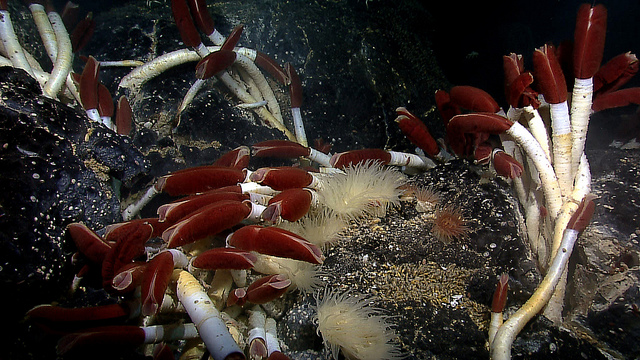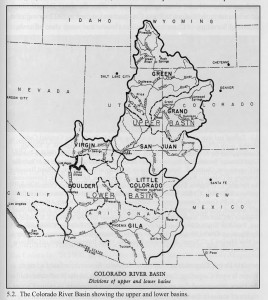 This story, I promise, will end with giant deep-sea tubeworms like the beauties above. Please bear with me while I get there via the Colorado River.
This story, I promise, will end with giant deep-sea tubeworms like the beauties above. Please bear with me while I get there via the Colorado River.
I’m one of the nearly 40 million people who depend on the Colorado for water, and for most of my adult life I’ve heard about (and reported on) the bureaucratic battles over the river’s flow. Over the past century, the seven arid states that share the river — “share” being a generous term here — have tried to protect their portions with multiple lawsuits, clever insults, and, in one notorious case, the Arizona National Guard.
So when I recently moderated a panel at the Aspen Environment Forum about the future of the Colorado River, I expected to hear about more of the same. Surely, I thought, drought and population growth are only ratcheting up the drama.
Instead, deputy secretary of the U.S. Department of the Interior David Hayes, ecologist Osvel Hinojosa Huerta of the Mexican conservation group Pronatura Noroeste and University of Arizona paleoclimatologist Jonathan Overpeck all described something that sounded suspiciously close to adult behavior. The outlook for climate and water supplies on the Colorado is grim and getting grimmer, they agreed, but the basin states have reached a few important cooperative agreements in recent years, and are even involved in promising discussions with Mexico about getting more water across the border and to the river’s dried-out delta.
I was skeptical. (That’s my job.) But Hayes, Hinojosa, and Overpeck each insisted, in public and in private, that the progress was real. Part of the reason, Hayes said, is that the veteran adversaries along the river have developed a grudging trust: “These people have worked together for so long,” he said, laughing and shaking his head. “They know each others’ tics, they know each others’ food preferences. They’re like a family.”

The other reason, the panelists said, is the reality of the river. Over the past decade, everyone in the basin has tasted the bitterness of bad drought, and while some Western politicians continue to express doubt about the existence of climate change, most water officials in the basin states know the science and fear the future. When the Colorado River was divvied up among the states by the 1922 Colorado River Compact, negotiators assumed an average annual flow of 16.5 million acre-feet per year. (The standard approximation of an acre-foot is the amount of water needed to cover a football field with a foot-deep puddle. A six-pack of Polygamy Porter and undying gratitude to anyone who can come up with a better one.) Scientists have long known that the compact was signed during an unusually wet period, but their worst-case scenarios keep getting worse. Overpeck and colleagues now estimate that one of the region’s typically severe periodic droughts combined with climate change could reduce the flow to about 8 million acre-feet — less than half the theoretical “average” amount divided by the compact. Hayes, Hinojosa, and Overpeck suggested that such numbers are enough to scare the states into cooperating.
A few days after the conference, my daughter and I got out of the summer heat and wildfire smoke and took a quick trip to the Colorado high country, where we visited with ecologist Rafe Sagarin at the Rocky Mountain Biological Laboratory. Rafe has notably eclectic interests, and he’s always doing something worth knowing about; his two most recent books are Learning from the Octopus, about applying lessons from the natural world to national security strategies, and the just-released Observation and Ecology, about the importance of seemingly old-fashioned natural history to modern ecological insights.
I told Rafe about the conversation at the Aspen conference, and he nodded. “Symbiosis,” he said. While resource scarcity is often assumed to lead inevitably to conflict (how many times have we heard about the coming water wars?) crisis can also have the opposite effect, and inspire cooperation even among hardened enemies. In Learning from the Octopus, Rafe writes about the ubiquity, diversity and productivity of symbiotic relationships in nature, and about their parallels in human society. Cooperative relationships, he says, are especially important in harsh conditions: Deep-sea tubeworms, for example, lack mouths and guts, so they depend on colonies of obligate symbiotic bacteria to fix hydrogen sulfide into food for them. (See? I promised tubeworms.) In the human world, decentralized partnerships among Israelis, Palestinians, and Jordanians and among the frenemy states along the Mekong River have successfully identified and contained disease outbreaks. Because of the Mekong partnership, public-health workers were allowed into highly restricted Myanmar just days after a devastating cyclone hit the country in 2008. (Rafe also reports that members of the Middle East consortium collaborated on one of the first scientific papers jointly authored by an Israeli and a Palestinian.) He adds:
The networks were not designed to tackle the much larger and complex issues of creating peace between their member states, though they very well may be an opening to future peace agreements. Symbioses in nature never solve all of an organism’s security problems, but where new symbioses develop, they arise to solve the most immediate challenges. It may be that later, these relatively limited acts of symbiosis build into amazing outcomes that no one could have predicted.
I don’t want to make too much of this. Not all crises lead to cooperation, and the ongoing Colorado water crisis won’t be solved quickly or easily. But if water negotiators in the western United States can bring themselves to act like giant tubeworms — even a little bit — then there’s hope for us all.
Top photo courtesy of NOAA, from the “Tempus Fugit” vent field.
Colorado River Basin illustration courtesy of the Library of Congress.
Michelle, really enjoyed this post! I saw you moderate that panel in Aspen, great job on that too.
Best
Brian
Thanks very much, Brian!